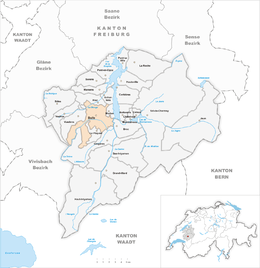Bulle
| Bulle | ||
|---|---|---|
 |
||
|
||
| Coordinates: 46°37′N 7°3′E / 46.617°N 7.050°ECoordinates: 46°37′N 7°3′E / 46.617°N 7.050°E | ||
| Country | Switzerland | |
| Canton | Fribourg | |
| District | Gruyère | |
| Government | ||
| • Mayor |
Syndic (list) Yves Menoud CVP/PDC (as of 2009) |
|
| Area | ||
| • Total | 23.87 km2 (9.22 sq mi) | |
| Elevation | 771 m (2,530 ft) | |
| Population (Dec 2015) | ||
| • Total | 21,991 | |
| • Density | 920/km2 (2,400/sq mi) | |
| Postal code | 1630 Bulle, 1635 La Tour-de-Trême | |
| SFOS number | 2125 | |
| Localities | Bulle, La Tour-de-Trême | |
| Surrounded by | Echarlens, Gruyères, Morlon, Le Pâquier-Montbarry, Riaz, Vuadens | |
| Website |
www SFSO statistics |
|
Bulle (French pronunciation: [byl], Arpitan: ![]() Bulo ) is a municipality in the district of Gruyère in the canton of Fribourg in Switzerland. In January 2006 Bulle incorporated the formerly independent municipality of La Tour-de-Trême.
Bulo ) is a municipality in the district of Gruyère in the canton of Fribourg in Switzerland. In January 2006 Bulle incorporated the formerly independent municipality of La Tour-de-Trême.
Bulle is first mentioned in the 9th century as Butulum. In 1200 it was mentioned as Bollo. The municipality was formerly known by its German name Boll, however, that name is no longer used.
Very little is known about the early history of the Bulle area. In 1995, a large grave mound from the early Hallstatt period was partially excavated. The grave mound lies about 300 m (980 ft) from the hill on which the church was later built.
During the Early Middle Ages it was the home of a parish church that covered a large parish. This Church of St. Eusebius was probably built in the 6th or 7th century by the Bishop of Lausanne. The church is mentioned several times between 852-875. In the 9th century, the parish was split into several independent parishes. As the parish shrunk in size, the church gradually lost its former importance, but it remained the center of the Decanate of Ogo until the 16th century. The deanery covered the whole Saanen valley to Treyvaux, the Jaun and Sionge valleys and extended west to Glâne. Bulle probably came under the secular power of the Bishop of Lausanne as early as the 6th century, and together with Avenches and Curtilles formed the territory originally owned by the bishop.
...
Wikipedia



